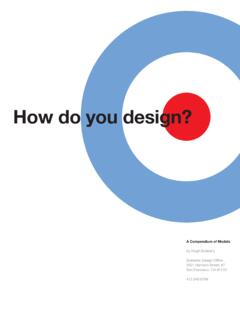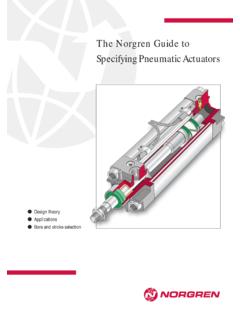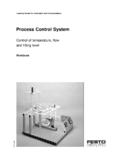Transcription of Interactions What is interaction Are there different types
1 ACM Interactions Volume January + February 2009 On Modeling Forum What is interaction ? are there different types ? Hugh Dubberly Dubberly Design Office Paul Pangaro Usman Haque Haque Design & Research When we discuss computer-human interaction and with a static object different from interaction with a design for interaction , do we agree on the meaning of dynamic system? the term interaction ? Has the subject been fully explored? Is the definition settled? An HCI View A Design-Theory View Canonical models of computer-human interaction are based on an archetypal structure the feedback loop. Meredith Davis has argued that interaction is not the Information flows from a system (perhaps a computer or a special province of computers alone. She points out that car) through a person and back through the system again. printed books invite interaction and that designers The person has a goal; she acts to achieve it in an consider how readers will interact with books.
2 She cites environment (provides input to the system); she measures Massimo Vignelli's work on the National Audubon Society the effect of her action on the environment (interprets Field Guide to North American Birds as an example of output from the system feedback) and then compares particularly thoughtful design for result with goal. The comparison (yielding difference or Richard Buchanan shares Davis's broad view of congruence) directs her next action, beginning the cycle interaction . Buchanan contrasts earlier design frames (a again. This is a simple self-correcting system more focus on form and, more recently, a focus on meaning technically, a first-order cybernetic system. and context) with a relatively new design frame (a focus In 1964 the HfG Ulm published a model of on interaction ).2 interaction is a way of framing the interaction depicting an information loop running from relationship between people and objects designed for system through human and back through the them and thus a way of framing the activity of design.
3 Don Norman has proposed a gulf model of All man-made objects offer the possibility for interaction , interaction . A gulf of execution and a gulf of and all design activities can be viewed as design for evaluation separate a user and a physical system. The same is true not only of objects but also user turns intention to action via an input device of spaces, messages, and systems. interaction is a key connected to the physical physical system aspect of function, and function is a key aspect of design. presents signals, which the user interprets and Davis and Buchanan expand the way we look at evaluates presumably in relation to design and suggest that artifact-human interaction be a Norman has also proposed a seven stages of criterion for evaluating the results of all design work. action model, a variation and elaboration on the gulf Their point of view raises the question: Is interaction Norman points out that behavior can be 1 What is interaction ? Man-Machine System Seven Stages of Action Man Forming the goal Forming Evaluating Receptors Effectors the intention the outcome Displays Controls Specifying Interpreting the the action state of the world The Observer Executing Perceiving the the action state of the world Mechanisms Input Output The World Gulf of Execution and Evaluation Action Specification Input Intentions Devices Gulf of Execution Physical User System Gulf of Evaluation Interface Evaluation Display Interpretation 2 What is interaction ?
4 interaction How do you . feel? map cool hot know? path handle button do? bottom up, in which an event in the world triggers the Haque argues that the process of clicking on a link to cycle, or top-down, in which a thought establishes a summon a new webpage is not interaction ; it is goal and triggers the cycle. If you don't say it, people reaction. The client-server system behind the link tend to think all behavior starts with a goal. It doesn't reacts automatically to input, just as a supermarket door it can be a response to the environment. (It is also opens automatically as you step on the mat in front of it. recursive: goals and actions trigger subgoals and Haque argued that in reaction' the transfer sub-actions). 6 function (which couples input to output) is fixed; in Like Norman's models, Bill Verplank's wonderful interaction ' the transfer function is dynamic, , in How do model of interaction interaction ' the precise way that input affects output'.
5 Is also a classic feedback loop. Feeling and doing can itself change; moreover in some categories of bridge the gap between user and interaction ' that which is classed as input' or output'. Representing interaction between a person and a can also change, even for a continuous system. 10. dynamic system as a simple feedback loop is a good For example, James Watt's fly-ball governor first approximation. It forefronts the role of information regulates the flow of steam to a piston turning a wheel. looping through both person and Perhaps The wheel moves a pulley that drives the fly-ball more important, it asks us to consider the user's goal, governor. As the wheel turns faster, the governor uses a placing the goal in the context of information theory mechanical linkage to narrow the aperture of the thus anchoring our intuition of the value of Alan steam-valve; with less steam the piston fills less quickly, Cooper's persona- goal-scenario design turning the wheel less quickly.
6 As the wheel slows, the In the feedback-loop model of interaction , a person governor expands the valve aperture, increasing steam is closely coupled with a dynamic system. The nature of and thus increasing the speed of the piston the system is unspecified. (The nature of the human is provides input to the wheel, but the governor translates unspecified, too!)The feedback-loop model of the output of the wheel into input for the is interaction raises three questions: What is the nature of a self-regulating system, maintaining the speed of the the dynamic system? What is the nature of the human? wheel a classic feedback loop. Do different types of dynamic systems enable different Of course, the steam engine does not operate types of interaction ? entirely on its own. It receives its goal from outside; a person sets the speed of the wheel by adjusting the length of the linkage connecting the fly-ball governor to A Systems-Theory View the steam valve. In Haque's terminology, the transfer function is changed.
7 The discussion that gave rise to this article began when Our model of the steam engine has the same Usman Haque observed that designers often use the underlying structure as the classic model of interaction word interactive' to describe systems that simply react described earlier! Both are closed information loops, to input, for example, describing a set of Web pages self-regulating systems, first- order cybernetic systems. connected by hyperlinks as interactive multimedia. While the feedback loop is a useful first approximation 3 What is interaction ? of human computer interaction , its similarity to a steam A self-regulating system has a goal defines engine may give us pause. a relationship between the system and its environment, The computer-human interaction loop differs from which the system seeks to attain and the steam-engine-governor interaction loop in two relationship is what the system regulates, what it seeks major ways. First, the role of the person:The person is to keep constant in the face of external forces.
8 A simple inside the computer-human interaction loop, while the self-regulating system (one with only a single loop). person is outside the steam-engine-governor cannot adjust its own goal; its goal can be adjusted only interaction loop. Second, the nature of the system:The by something outside the system. Such single-loop computer is not characterized in our model of systems are called first order.. computer-human interaction . All we know is that the Learning systems nest a first self-regulating system computer acts on input and provides output. But we inside a second self-regulating second have characterized the steam engine in some detail as a system measures the effect of the first system on the self-regulating system. Suppose we characterize the environment and adjusts the first system's goal computer with the same level of detail as the steam according to how well its own second-order goal is engine? Suppose we also characterize the person? being met.
9 The second system sets the goal of the first, based on external action. We may call this learning . modification of goals based on the effect of actions. types of Systems Learning systems are also called second-order systems. Some learning systems nest multiple self- So far, we have distinguished between static and regulating systems at the first level. In pursuing its own dynamic systems those that cannot act and thus have goal, the second-order system may choose which little or no meaningful effect on their environment (a first-order systems to activate. As the second-order chair, for example) and those that can and do act, thus system pursues its goal and tests options, it learns how changing their relationship to the environment. its actions affect the environment. Learning means Within dynamic systems, we have distinguished knowing which first-order systems can counter which between those that only react and those that interact disturbances by remembering those that succeeded in linear (open-loop) and closed-loop systems.
10 The past. Some closed-loop systems have a novel property A second-order system may in turn be nested within they can be self-regulating. But not all closed-loop another self-regulating process may systems are natural cycle of water is continue for additional levels. For convenience, the term a loop. Rain falls from the atmosphere and is absorbed second-order system sometimes refers to any higher- into the ground or runs into the sea. Water on the order system, regardless of the number of levels, ground or in the sea evaporates into the atmosphere. because from the perspective of the higher system, the But nowhere within the cycle is there a goal. lower systems are treated as if they were simply first- types of systems Water Cycle Systems Rain Clouds can be Static or Dynamic Cloud Formation Precipitation Evaporation + Condensation which can be Linear or Closed-loop Snow which can be Recirculating or Self-regulatory Lake which can be First- or Second-order Ocean Ground which can be Self-adjusting or Learning 4 What is interaction ?






